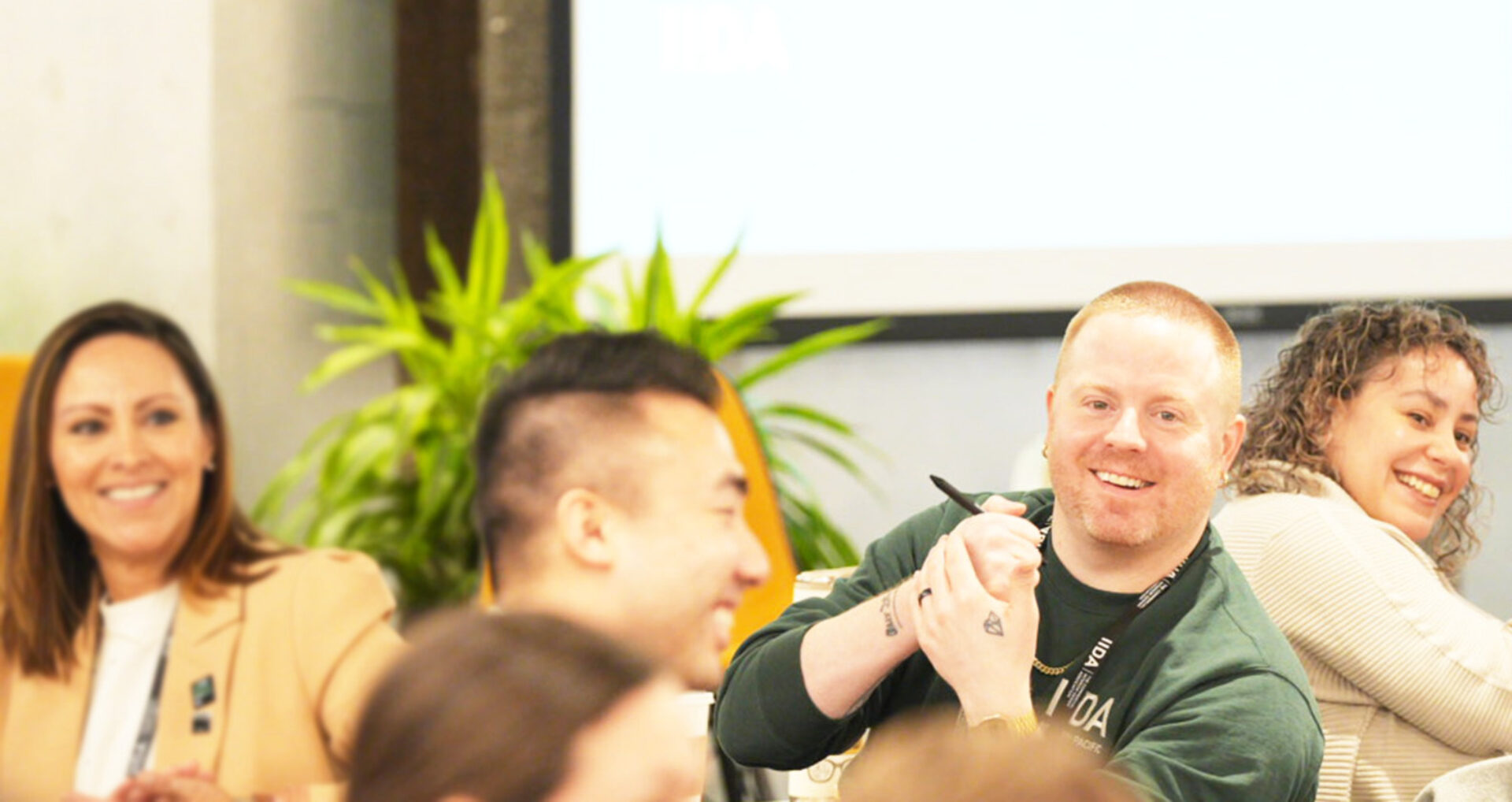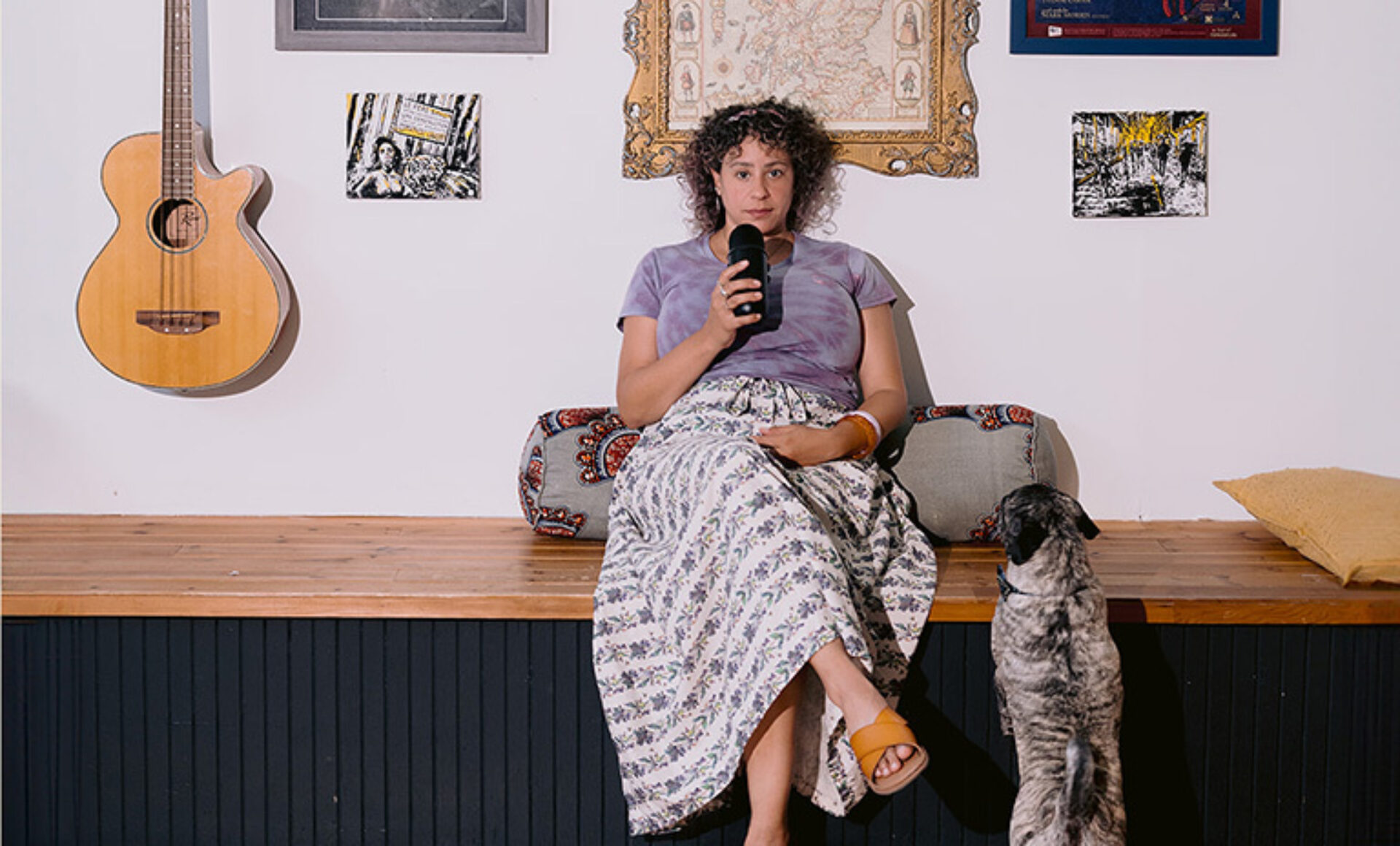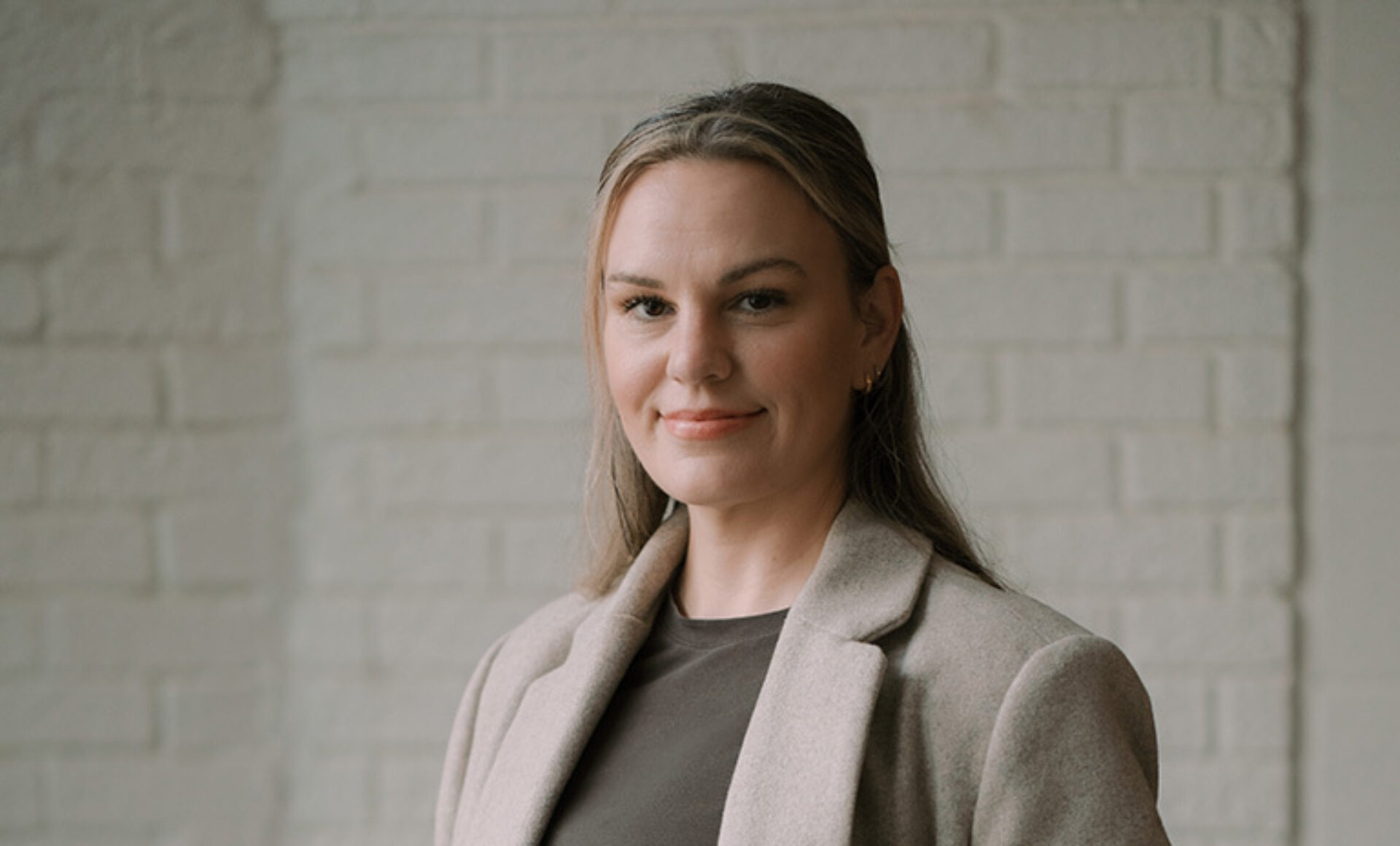Life is rarely a straight line, and the same can be said of career paths. There are periods of exploration and reconsideration. Glimmers of passion and bouts of uncertainty. But for those of us who are lucky, one day, some way, we find the thing we love — and chase it.
Take Matt Thompson, Assoc. IIDA, CDF, who lived many lives before he established a career in commercial interior design and became president of IIDA’s Northern Pacific Chapter — musical theater enthusiast, Pier 1 Imports employee, owner of a graphic T-shirt company. He accrued various, valuable experiences that have all served him in his design journey. After years as a practicing interior designer, Thompson transitioned to the sales side of the industry and now works with storied manufacturer MillerKnoll as a Strategic Relationship Executive.
We sat down with Thompson, a Certified Design Futurist who lives in Seattle, to learn more about his unexpected path to design; his chapter’s work advocating for the interior design profession; and why IIDA’s Senior Director of Advocacy, Marci Merola, calls him the “advocate’s advocate.”
The conversation below has been lightly edited for length and clarity.
What’s your origin story? What first drew you to design?
I was always a creative kid. I was in musical theater and show choir in high school. And in theater, beyond acting, you learn about set design, color, lighting. I spent two years as a musical theater major in college. I loved doing it, but I didn’t have the passion to make it as an actor. After a couple years, I left school for some other reasons. I didn’t really have a clear sense of what I wanted to do, so I started working retail. I worked at Pier 1 Imports and a few others.
RIP, Pier 1.
I know. I can still remember the smell and the candles and the decor. I moved to Seattle, and I was working for Pottery Barn, doing sales and visual merchandising. Through exploring visual merchandising, I landed on interior design, especially coming from stores that had both furniture and décor. I took the leap and went back to school at Bellevue Community College, which is now Bellevue College, which has a pretty robust and impressive interiors program. I had a roundabout way of finding interiors, born out of a passion for selling and a love of furniture.

Tell me about your favorite piece of furniture that you own.
Oh, man. Well, coincidentally, it is an Eames piece. I have a vintage Eames lounger, a 1970s chair and stool that I got at an auction. I love it, but it’s in storage, because the leather is all busted and I need to get it reupholstered. My husband and I just bought a house a year and a half ago, and it’s small — we live in Seattle, so it’s a small home. We don’t really have a place for it right now, and it needs some love. Now working at MillerKnoll, I was able to explore the new archives in West Michigan. Oh my gosh. They’re beautiful, astounding. I’m a lover of furniture. I’m a lover of interiors. I’m a lover of stuff. Much to my husband’s annoyance, sometimes, because I collect things.
You started your design career as a practitioner and later transitioned to the sales and strategy side. What inspired the pivot?
When I was a student at Bellevue College, I attended a student mentor day through IIDA. I had a wonderful mentor from [architecture and design firm] NBBJ, Ashlie Fuller, who suggested I apply for a summer internship. I was like, “It’s so early in my schooling, I don’t think I should, it’s not going to get me anywhere.” She said, “Just do it.” I did, and magically, I ended up with a summer internship at NBBJ. I was the only local intern, and I jokingly say that I just didn’t leave. I worked at NBBJ for five years total — in the healthcare studio, and then in the hospitality and retail studio. I had a wonderful time. I learned a ton about design and how this whole industry works. Then, in 2008, the market crashed. There were some layoffs, and of course, a junior designer who had moved from the healthcare studio to the hospitality and retail studio was going to be released at that point. I jokingly say now that if I had stayed in healthcare, maybe I’d still be a designer.
After I left design in 2008, I took some time to figure out what I wanted to do. My now-ex-husband and I started a graphic T-shirt line and started selling at a Sunday market here in Seattle. I still loved design and wanted to stay connected to the industry, but I wasn’t sure if I wanted to continue as a designer, exactly. I ended up going to a dealer and moved into the sales side; I’d found a way to apply those years of retail experience. I worked for a KI dealer, and then moved to a Miller dealer — who I now work with really closely through my work at MillerKnoll. I spent six years with dealers, and at the same time, the T-shirt line was growing and expanding. I had to make a decision: I left my full-time job and dove fully into the T-shirt business with my co-founder. Even though I had left the interior design industry, I was still engaged — I even printed T-shirts for IIDA.
What skills did you learn that carry through into your work today?
The T-shirt brand was awesome. We went from zero to selling millions of dollars of T-shirts every year. Retailers around the world carried us. I honed a lot of business skills — marketing, sales, accounting, people management. Eventually, the market shifted, and we decided we couldn’t handle two full-time owners, so I stepped away. The business is still around; my ex runs it now. I told myself I wasn’t going to go back into furniture, I would try something different. Then a recruiter called, and I ended up going to a Steelcase dealer. Anyone who works in the industry of interiors, especially on the sales side, knows it’s a boomerang industry. You tend to come back.
Through all of that, IIDA has been there — when I was a student, designer, industry member, out of the industry, and now back, IIDA has been at some point along that line.
What impact has IIDA membership had on your career?
Maybe I’d be where I’m at in my career, as far as working at a legacy brand like MillerKnoll, without IIDA, but I think it would have been a harder path. The learning that you gain as a leader in an IIDA chapter is invaluable. You’re learning business skills, budgeting, interpersonal skills. Through my time on the chapter board, in various roles, I have been able to utilize the connections I’m making with designers to help in my career. It has also been a wonderful opportunity to support members, support our chapter, and support the industry as a whole.
Interior design affects the health, safety, and welfare of my friends and family, and everyone else, as we move through public space. And as an IIDA member ... I want designers who are educated, experienced, and certified to have the ability to practice to their full scope, without having to get their design work stamped and sealed by architects.
Matt Thompson, IIDA Northern Pacific
Your chapter, IIDA Northern Pacific, is spearheading multiple advocacy efforts right now. Talk us through the efforts you’re helming as president.
Our chapter covers Alaska, Idaho, Washington, and two Canadian provinces. I always say, I am not NCIDQ-certified, I’m not a practitioner, but I’m supporting the work that these certified practitioners are doing in the field. All three of our American states are currently working on legislation.
In Washington, we are in what we call “stakeholdering,” which means we’re having conversations with those who have a stake in the work of the built environment. These stakeholders include AIA [the American Institute of Architects] and ASID [the American Society of Interior Designers]. The Consortium for Interior Design – Washington (comprised of the IIDA Northern Pacific Chapter and ASID WA) and AIA Washington Council are collaborating through a joint task force process to explore 2026 legislation for commercial interior designers in Washington state.
That means, in part, talking through the three E’s — the Education, Experience, and Examination that commercial interior designers go through. Our aspirational goal is a title act with stamp and seal privileges.

In Idaho, we’re on a similar path right now, with similar timelines and goals. I was just in Boise recently for Capitol Day, and I was able to talk to some state legislators in the hallways. If someone had told me when I was a design student that one day I’d be talking to senators about interior design legislation, I would have said they were crazy.
In Alaska, we had a bill that moved through a state senate committee last session and was unfortunately never able to come up for a vote on the floor. Local advocates recently reintroduced the bill, in hopes that it will be voted on in the current legislative session. We’re feeling confident.
We have a national Consortium for Interior Design, a partnership between IIDA, ASID [the American Society of Interior Designers], and CIDQ [the Council for Interior Design Qualification], and we have state consortiums in Washington, Idaho, and Alaska, working together to advocate for the profession on the state level. We didn’t have that back in the day, so that’s been really helpful.
What do you wish more members of the public understood about interior design?
Channels like HGTV helped educate the public on color and space and the excitement of furniture, but it also simplified the work that designers do, especially in commercial spaces. Think about how important it is that hospitals and kindergarten classrooms, for instance, are safe. The architecture is important, ensuring that the building doesn’t fall down. But making sure the flooring tile in the entryway isn’t too slippery when it gets wet — that’s important, too. Those are the kind of decisions, multiplied by millions, that interior designers are making as they think about public spaces. Yes, that includes color and finishes, but people probably don’t know that there’s theory and science behind the color of walls; there’s science behind the coefficient of friction, which helps us make sure floor tile isn’t too slippery. Designers also have a deep understanding of building codes laid out by jurisdictions across the country.
You are not currently practicing design, but you’re advocating for design practitioners. Why do you think other non-practitioners should get involved?
Interior design affects the health, safety, and welfare of my friends and family, and everyone else, as we move through public space. And as an IIDA member, I want to see a robust, healthy industry. I want designers who are educated, experienced, and certified to have the ability to practice to their full scope, without having to get their design work stamped and sealed by architects.
It's easy for those who aren’t interior designers to say, it’s not my fight. I don’t want to get in the way, I don’t want to step on their toes. But I think it’s imperative as a non-practitioner to be educated on this topic, to be able to talk to your friends, family, and the public about the crucial work designers do. It’s one thing for designers to advocate for the profession, but it’s also really important for those who aren’t practitioners to step up and say this benefits everybody.
As someone who’s worked across the design industry, what advice would you give someone who wants to enter the profession?
Don’t be discouraged by what might be perceived as some uncertainty in the field. Our industry is affected by what’s happening in the world, but I would encourage you to engage. Find your path. You may be in design school today, but where you end up? Man, who knows. You could move into sales, product development. There are so many paths in our industry. And things are always changing, especially now. The way we execute on projects, the way we sell and install furniture is not how we’re going to do it in five years. There will be elements that carry through. There will always be napkin sketches, but the napkin probably will change. You could find an unexpected niche and have an amazing career in a wonderful industry, and you may not even know your future role exists, because it probably doesn’t yet.






